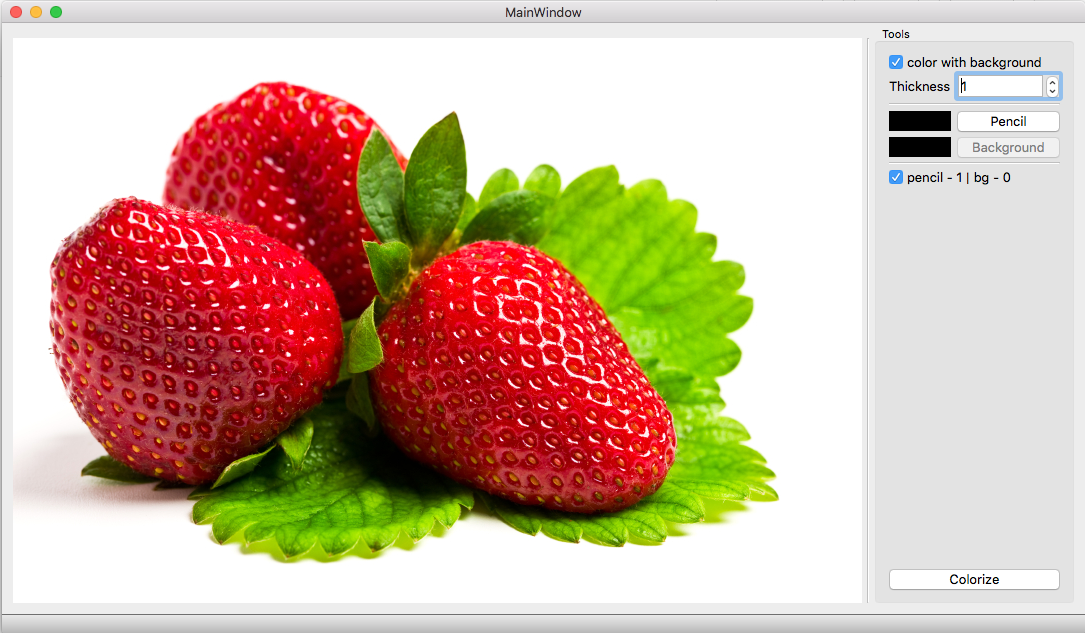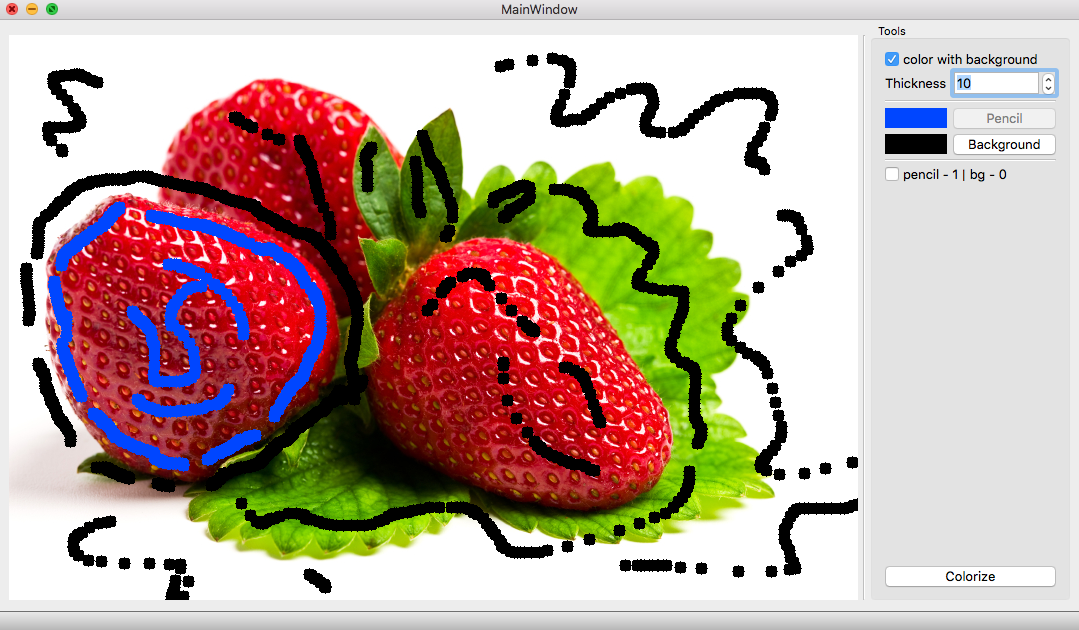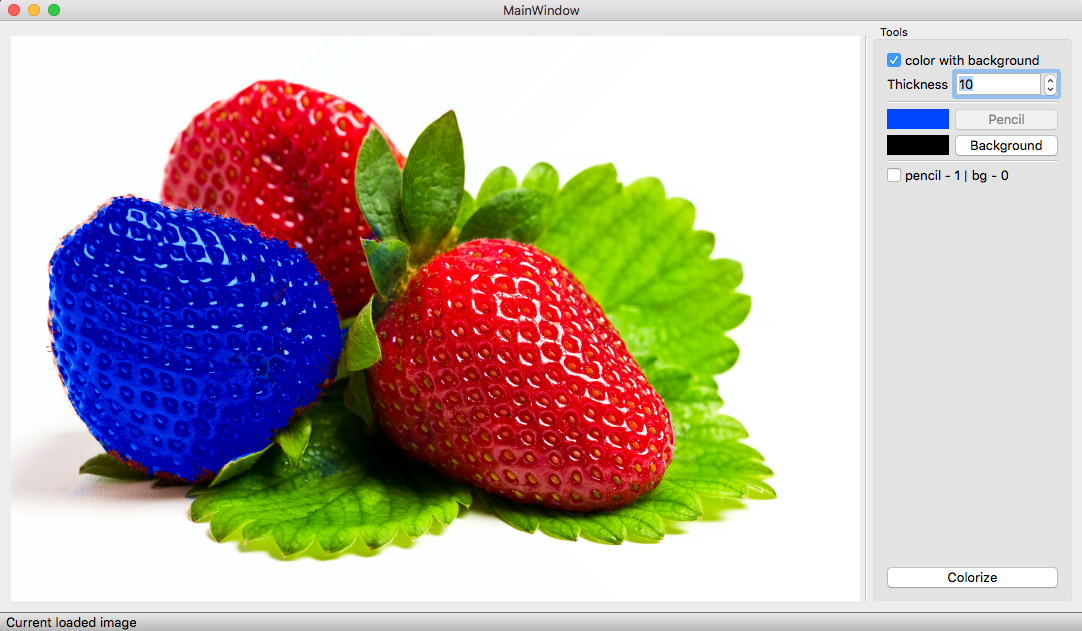Color It
This project was done as a part of course Image Analysis wherein I developed a tool
Color It using openCV library and Qt(GUI).
Just by coloring 3-4 percent of the image, we can color the whole image while maintaining the original luminance.
The algorithm works as follows:
- Convert the image in
YCbCrcolor space fromRGBcolor space. - Recolor the small portion of the image and take those color
Cb,Crand replace the original image’s at those pixels. - Propogate those
Cb,Crcomponent using simple dijkstra algorithm where the weights keep on increasing further away the pixel is from the pixels with fixedCb,Cr. - Have a bucket of size 3 or 4 for each pixel which will maintain the top 3, 4 colors having minimum weight at those pixels.
- Take weighted sum of all the colors in the bucket and set
CbCrof the original image.
You can find the source on my github repository.
I used only one main class named ColorBlender.
class ColorBlender {
private:
const Mat* grayImg;
const Mat* layerImg;
Vec3b bgColor;
Mat* output;
protected:
BlendPixel*** pixelArray;
queue<BlendPixel *> activeQueue;
// expand the frontier
void propogateColor();
// color the picture
void blendColor(const Mat *original = nullptr);
// generate the colored set
void generateColoredSet();
// pixel modified wrt test pixel
bool modifyPixel(BlendPixel &cur, BlendPixel &test);
// allocate pixelArray
void allocateArray();
// release pixelArray
void releaseArray();
// a simple weight function
inline double weight(double d);
void assertImage();
public:
virtual ~ColorBlender() { }
ColorBlender() { }
Mat* colorize(const Mat* _grayImageInRGB, const Mat* _layerImageInRGB);
Mat* colorize(const Mat* _grayImageInRGB, const Mat* _layerImageInRGB, const Vec3b backgroundColorInRGB);
};The only public function colorize returns the output image. If a background color is provided then whenever in the code that color is encountered, the original CbCr is used from the image.
The propogation works as follows:
void ColorBlender::propogateColor() {
int rows = grayImg->rows;
int cols = grayImg->cols;
while(!activeQueue.empty()){
BlendPixel *pixel = activeQueue.front();
activeQueue.pop();
for (int y = pixel->y - 1; y <= pixel->y + 1; ++y) {
for (int x = pixel->x - 1; x <= pixel->x + 1; ++x) {
if (x != pixel->x || y != pixel->y) {
if (x >= 0 && x < cols && y >= 0 && y < rows) {
BlendPixel *testPixel = pixelArray[y][x];
if (modifyPixel(*pixel, *testPixel))activeQueue.push(testPixel);
}
}
}
}
}
}In the starting activeQueue contains all the pixel that are colored in the layered image(color by the user). Each time the loop is executed, color is propogated to the neighbors if the propogated color have lesser weight than any of the colors present in the bucket of neighbor.
If the color is propogated then modifyPixel returns true otherwise false.
The working of modifyPixel is as follows:
bool ColorBlender::modifyPixel(BlendPixel &cur, BlendPixel &test) {
double y1 = cur.Y;
double y2 = test.Y;
double d = abs(y1 - y2);
bool result = false;
for(int i=0; i < MAX_BLEND_COLOR; i++){
if(cur.dist[i] < MAX_DISTANCE){
int j=0;
while(cur.dist[i] + d >= test.dist[j] && j < MAX_BLEND_COLOR){
if(cur.cb[i] == test.cb[j] && cur.cr[i] == test.cr[j]){
j=MAX_BLEND_COLOR;
break;
}
j++;
}
if(j < MAX_BLEND_COLOR){
if(cur.cb[i] != test.cb[j] && cur.cr[i] != test.cr[j]){
for(int k=MAX_BLEND_COLOR-1; k > j; k--){
if(test.cb[k-1]!=cur.cb[i] && test.cr[k-1]!=cur.cr[i]){
test.cb[k] = test.cr[k-1];
test.cr[k] = test.cr[k-1];
test.dist[k] = test.dist[k-1];
}
test.cb[j] = cur.cb[i];
test.cr[j] = cur.cr[i];
test.dist[j] = (float) (cur.dist[i] + d);
result = true;
}
}else{
break;
}
}
}
}
return result;
}Now what remains is to blend the colors which is the weighted average of all the colors in the bucket.
void ColorBlender::blendColor(const Mat *original) {
int rows = grayImg->rows;
int cols = grayImg->cols;
Mat colorMat;
cvtColor(*grayImg, colorMat, CV_RGB2YCrCb);
//cv::imshow("lasjf",colorMat);
for(int y=0; y<rows; ++y){
for(int x=0; x<cols; ++x){
double wsum=0;
double Cbsum=0;
double Crsum=0;
BlendPixel pixel = *pixelArray[y][x];
for(int k=0; k < MAX_BLEND_COLOR; k++){
if(pixel.dist[k] != MAX_DISTANCE){
double wk = weight(pixel.dist[k]);
wsum += wk;
if(original != nullptr &&
pixel.cb[k] == bgColor[1] &&
pixel.cr[k] == bgColor[2]){
Vec3b origColor = colorMat.at<Vec3b>(y, x);
Cbsum += wk * origColor[1];
Crsum += wk * origColor[2];
}else {
Cbsum += wk * pixel.cb[k];
Crsum += wk * pixel.cr[k];
}
}
}
Vec3b pixelValue = output->at<Vec3b>(y, x);
pixelValue[0] = pixel.Y;
if(wsum == 0){pixelValue[1] = 0; pixelValue[2] = 0;}
else {
pixelValue[1] = (uchar) (Cbsum / wsum);
pixelValue[2] = (uchar) (Crsum / wsum);
}
output->at<Vec3b>(y, x) = pixelValue;
}
}
}The weight of the color should be inversly propotional to the distance from the source colors. Hence any decreasing function will do the needful. But do keep in mind that if the weight function is behaving like constant then all colors will have same weight and which will result in color bleeding.
double ColorBlender::weight(double d) {
return pow(d+1, -5.0);
}After implementing basic UI code, the final result was like this.
Open any image

Color It

Click Colorize
